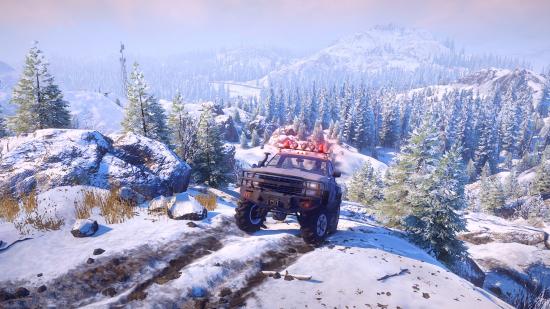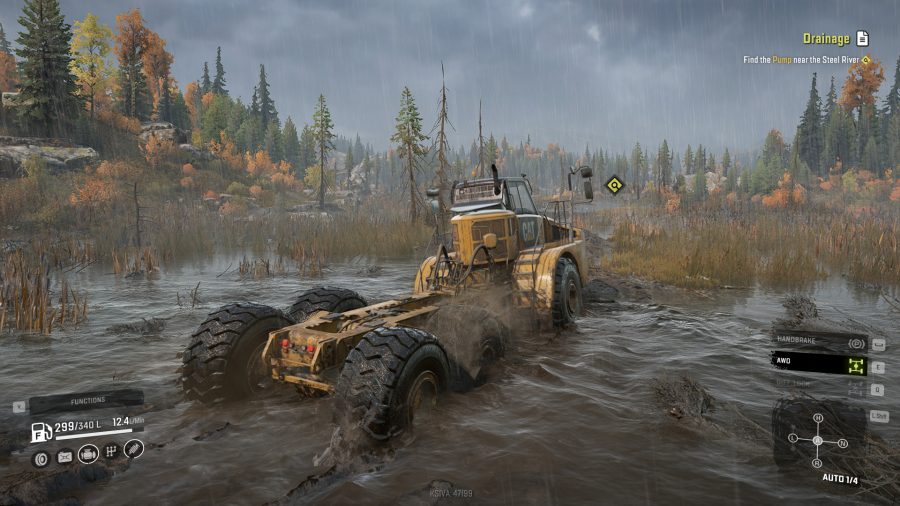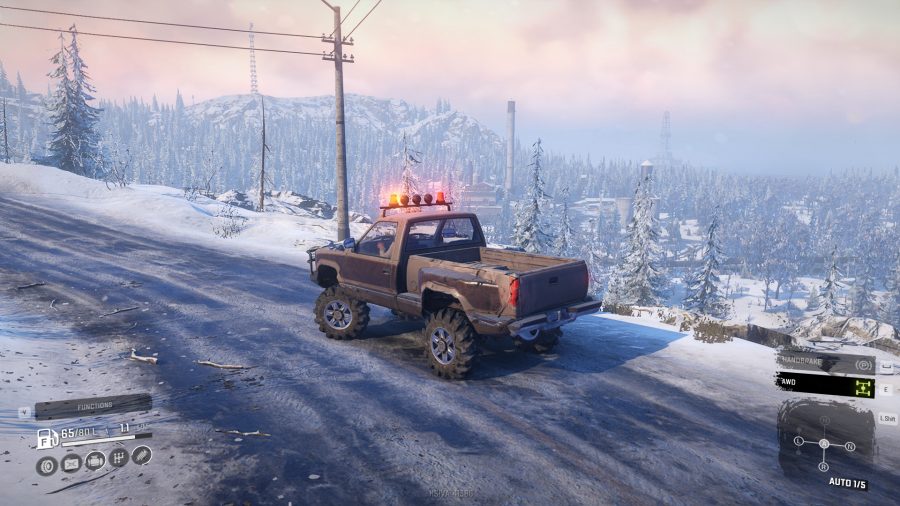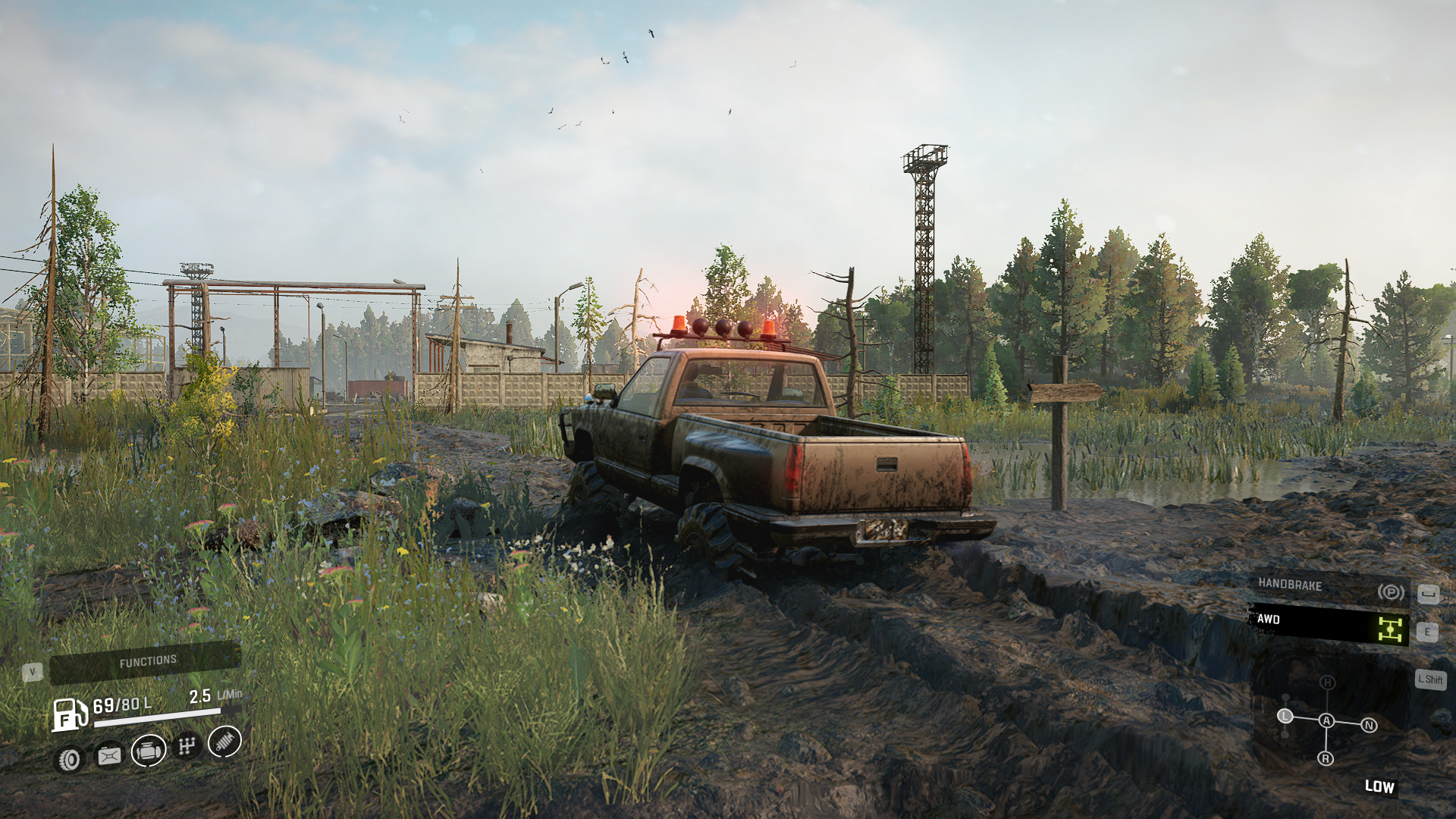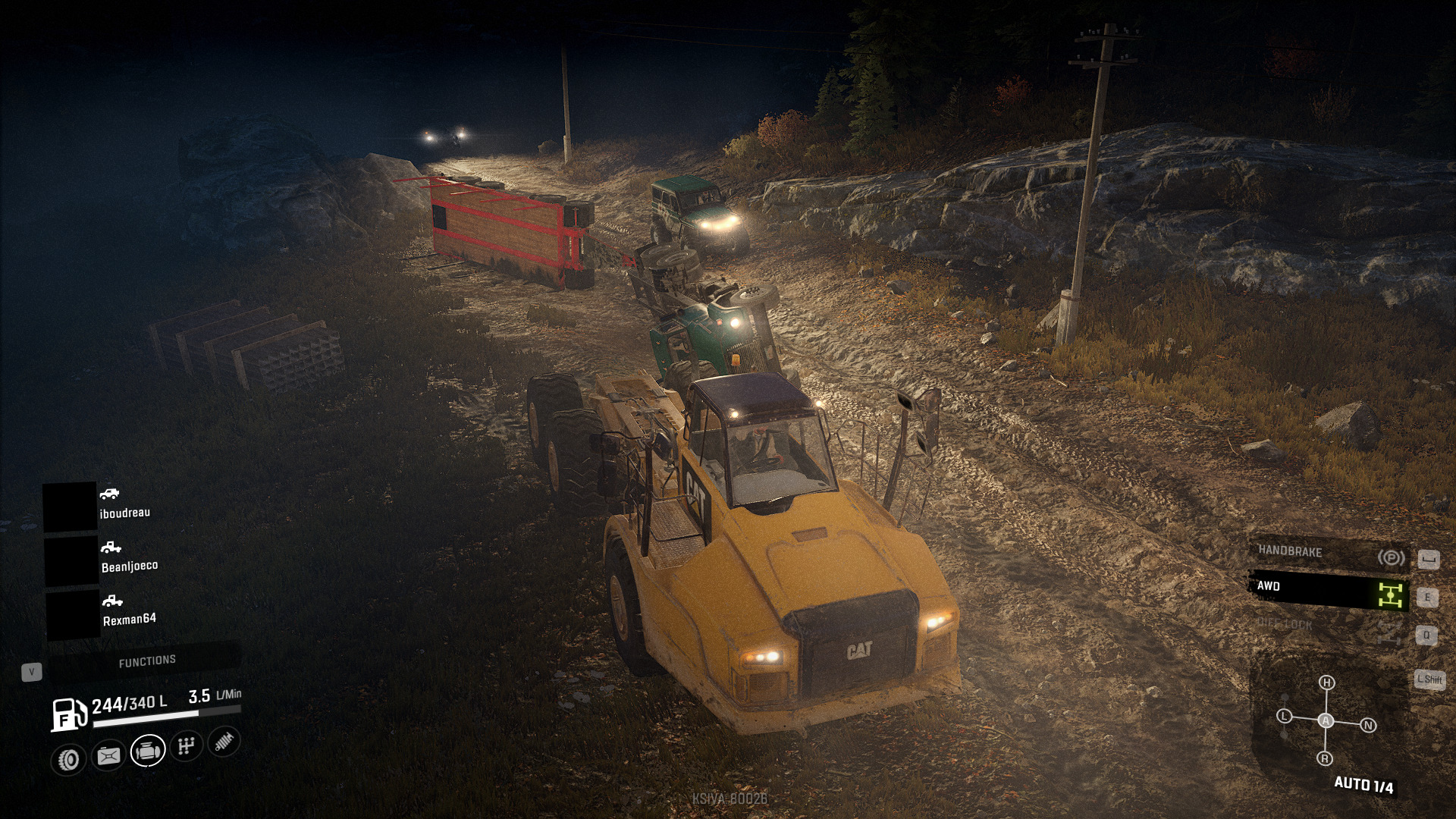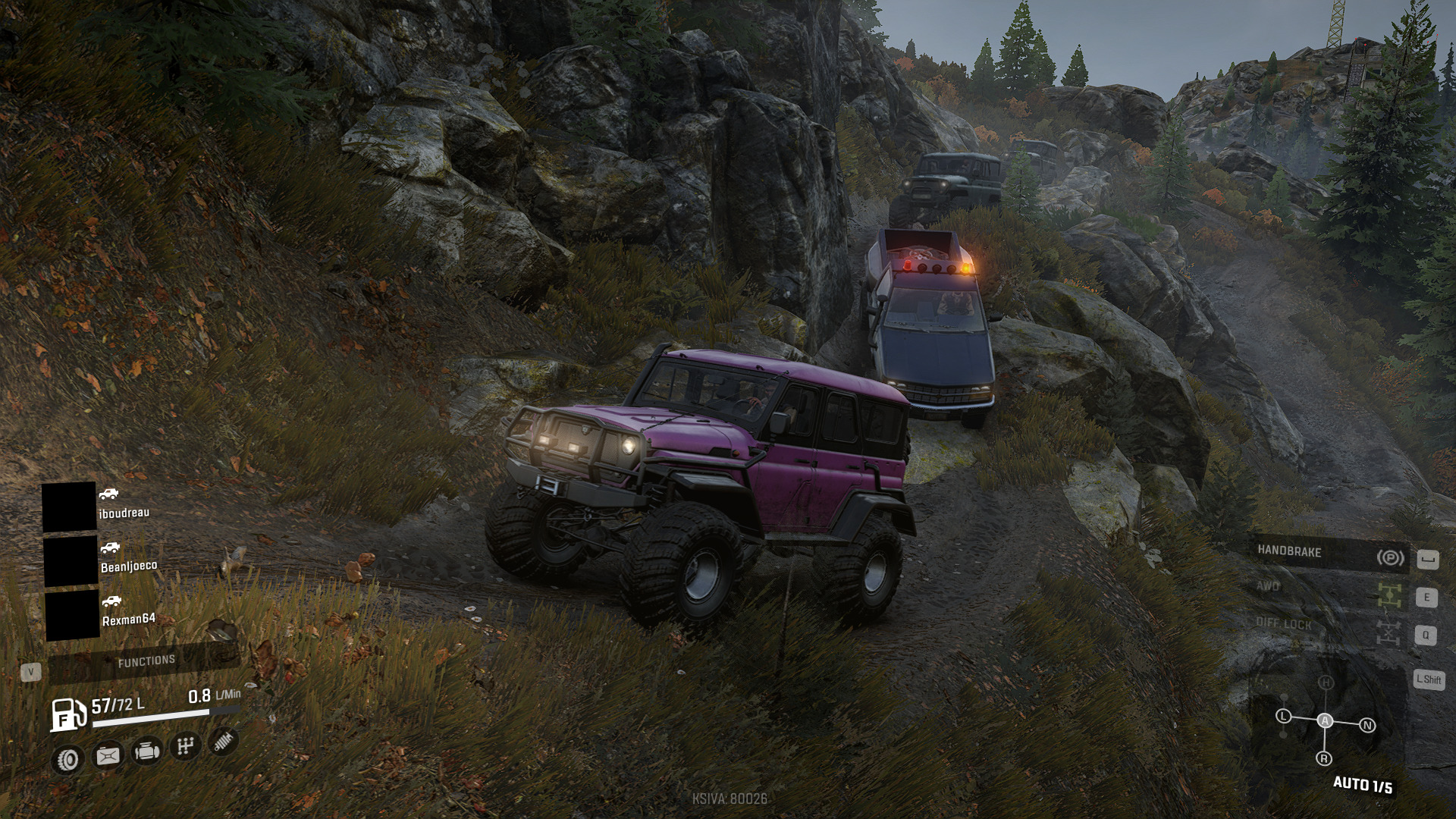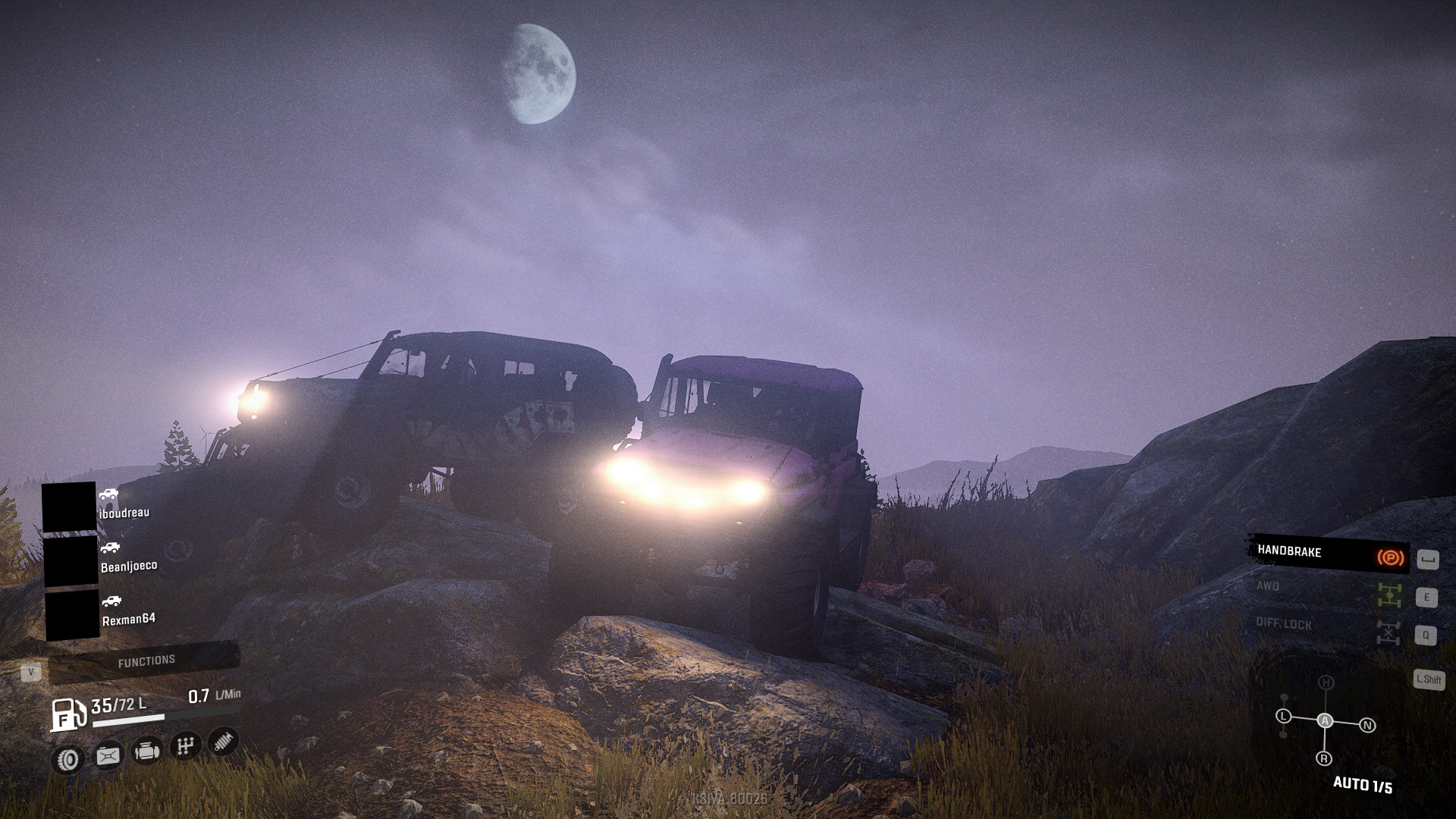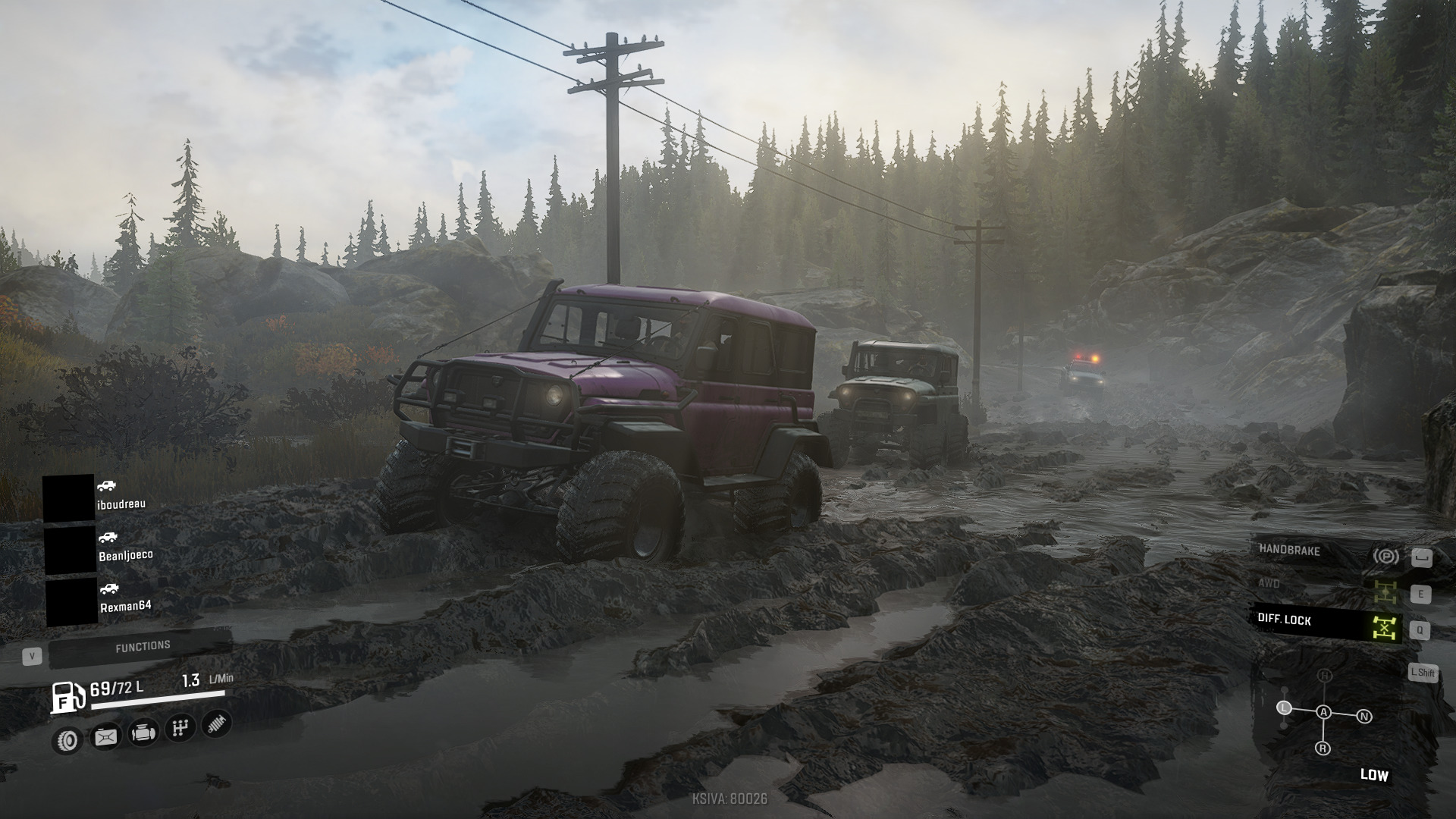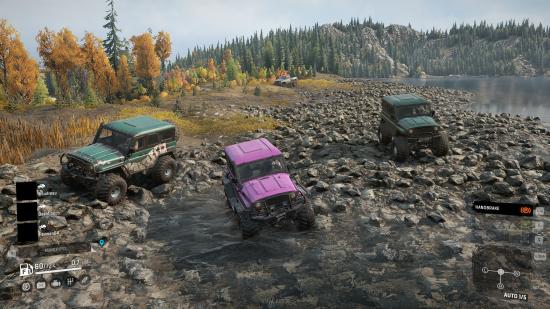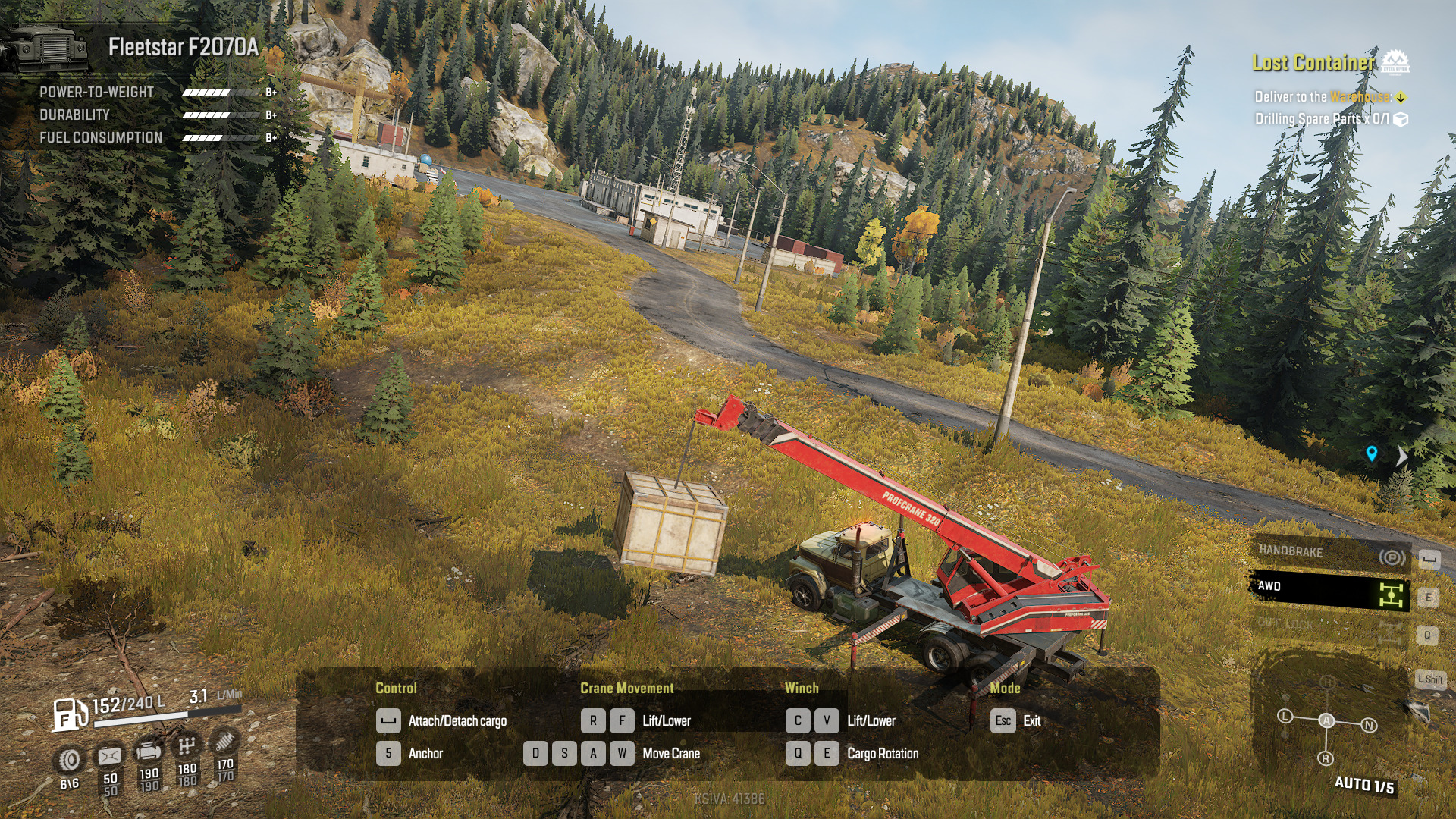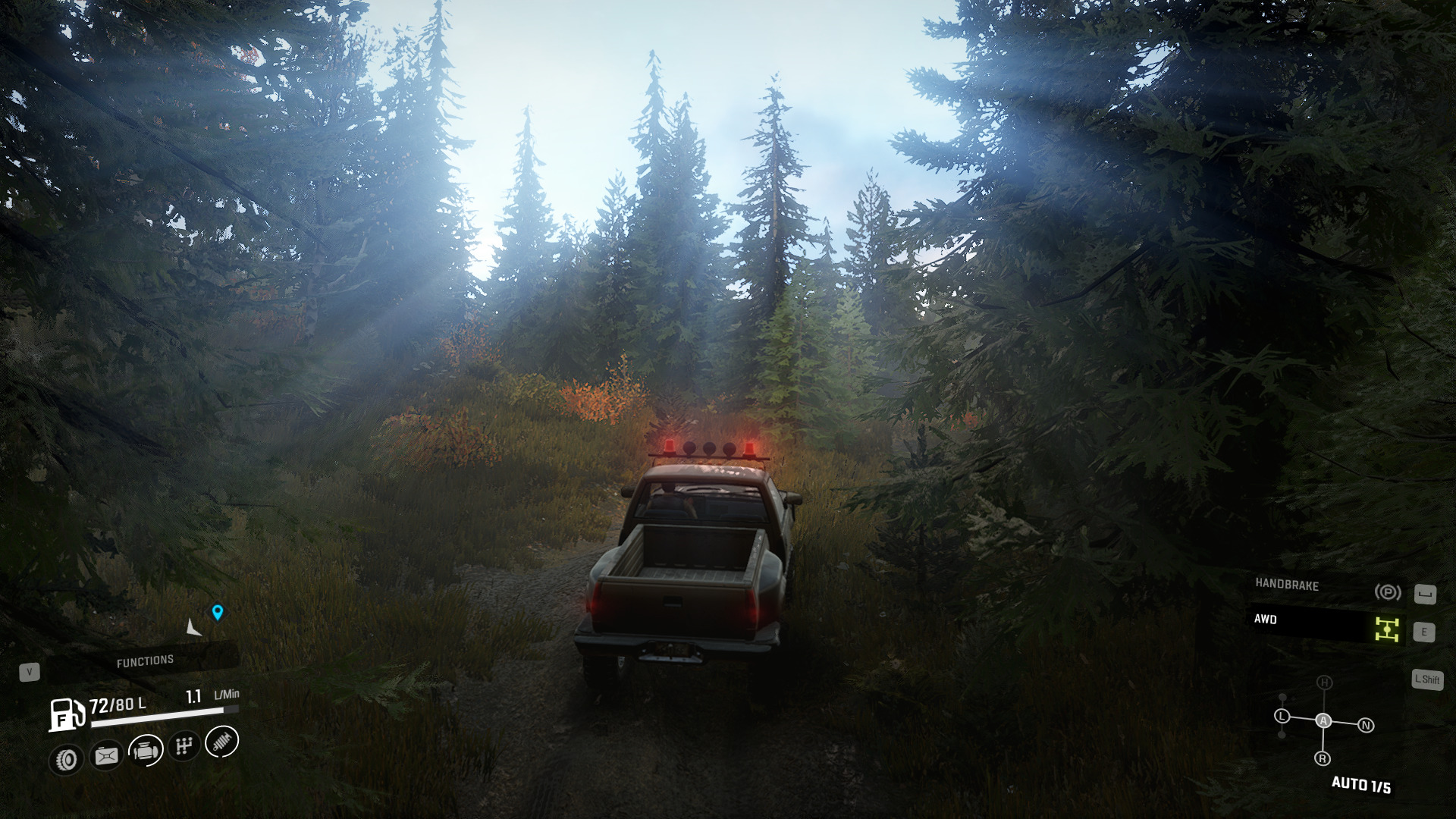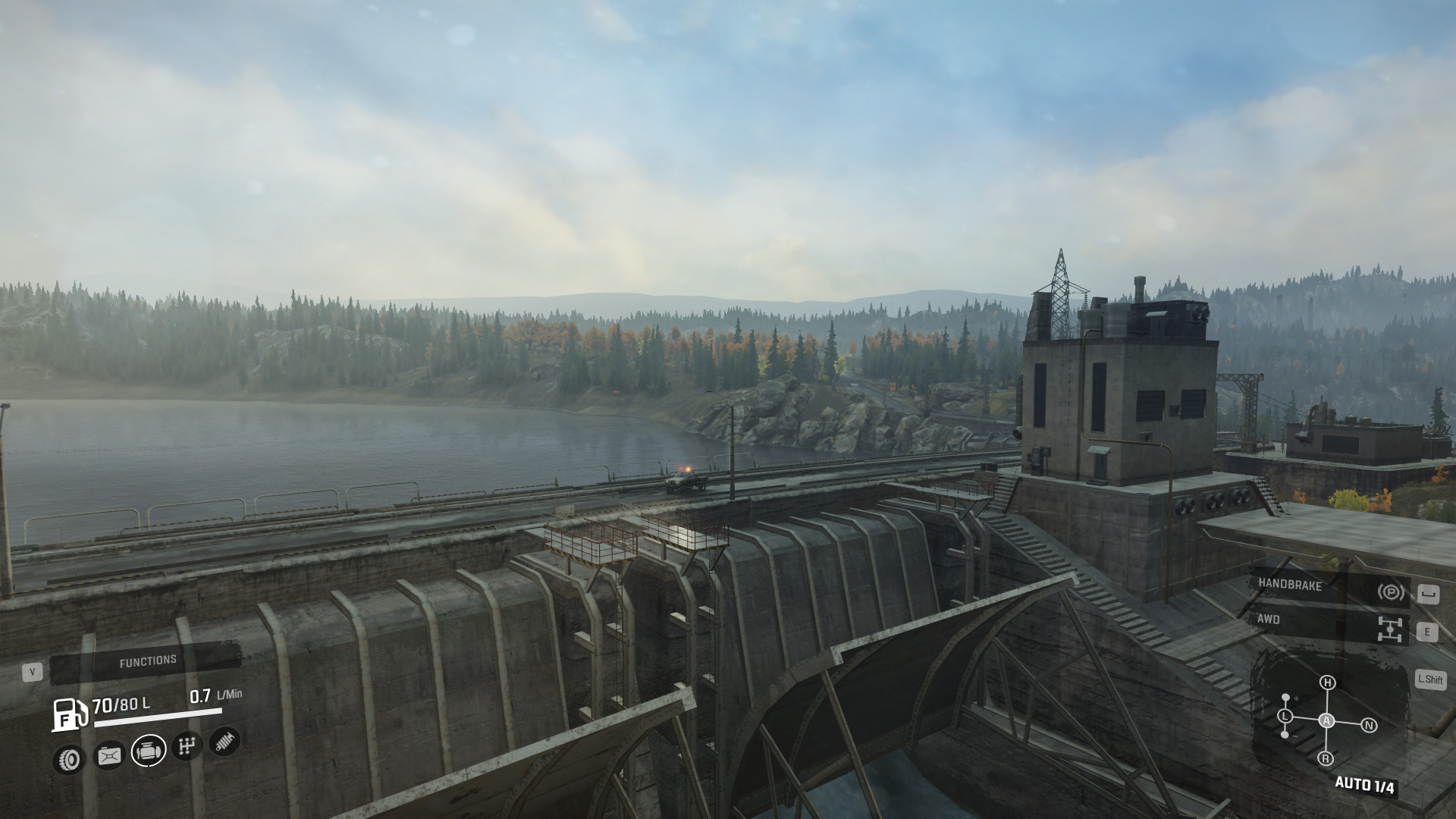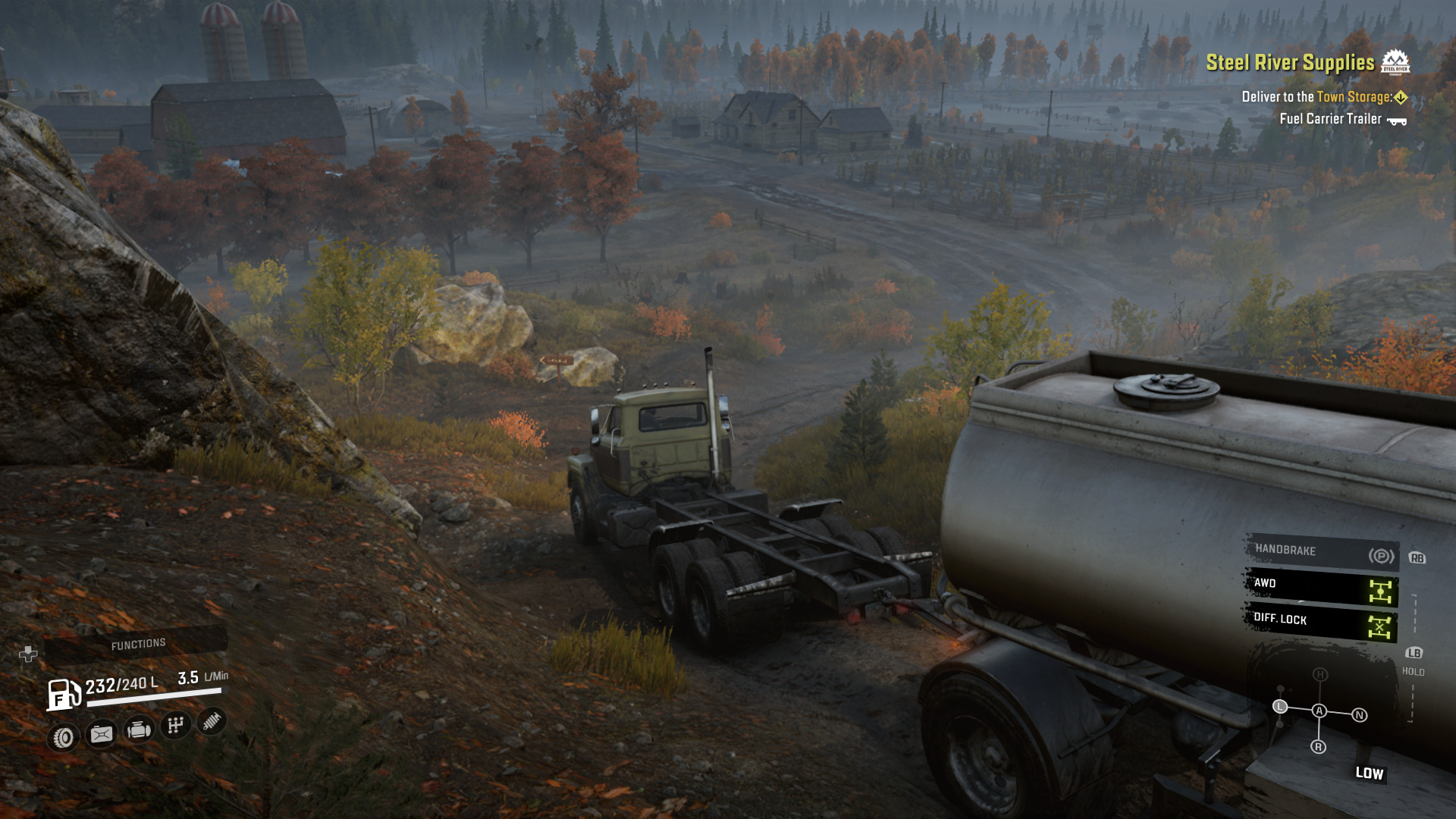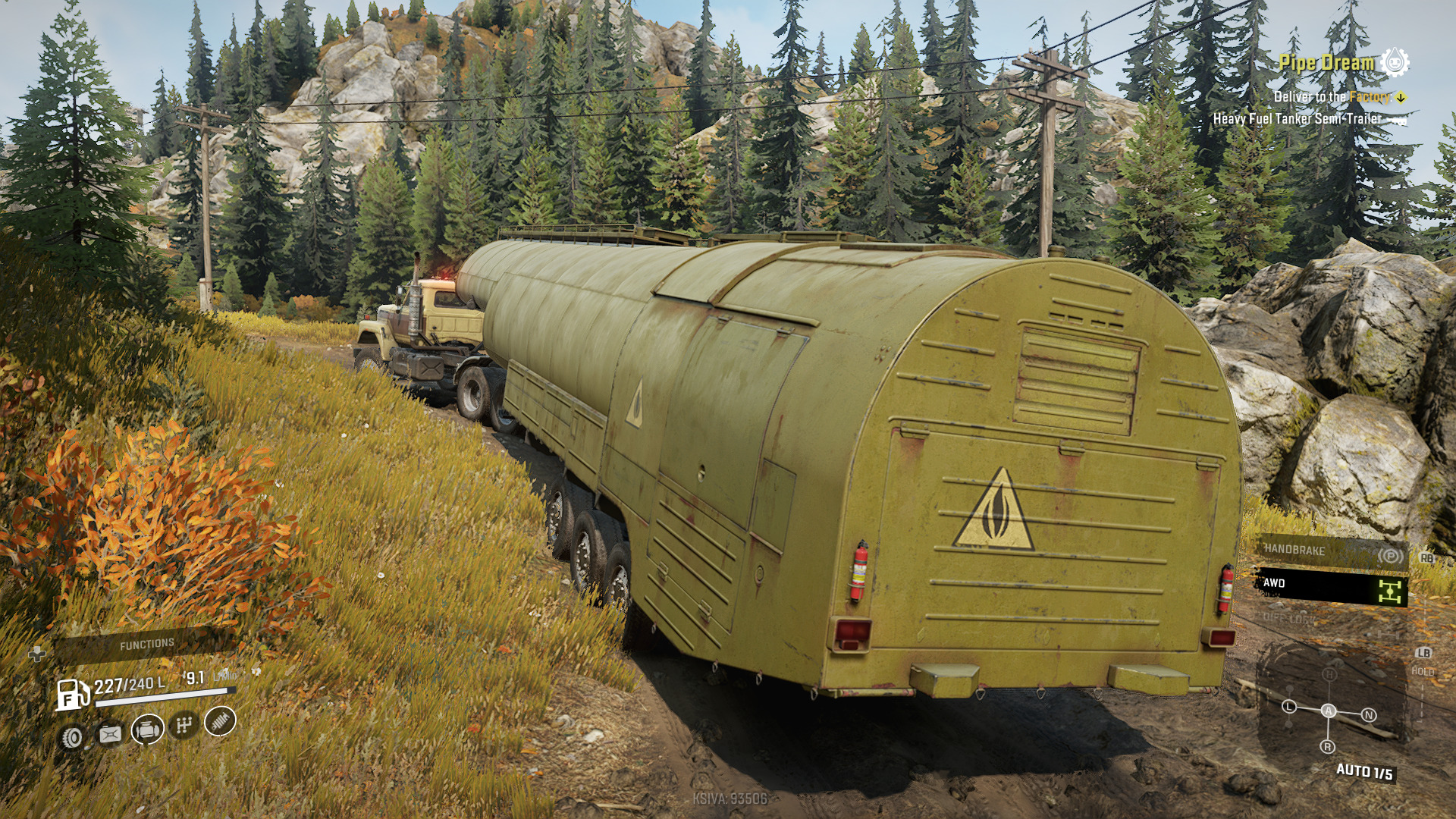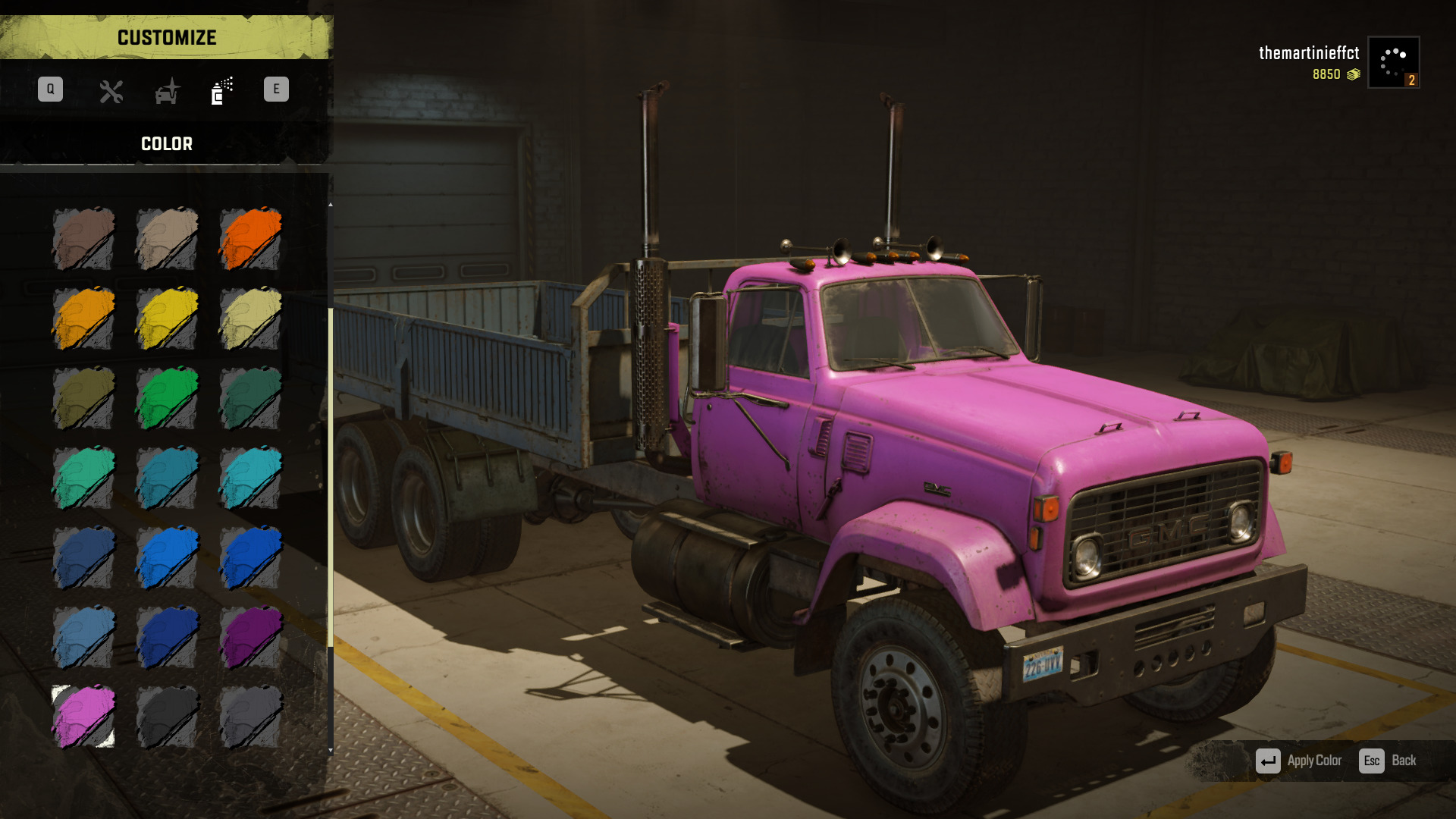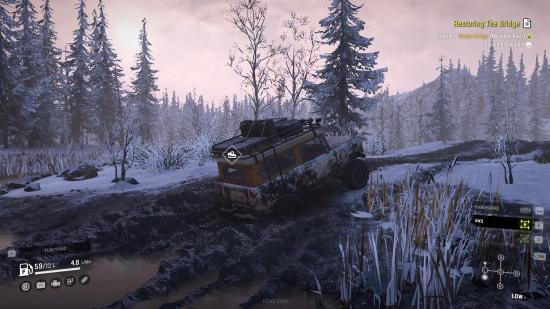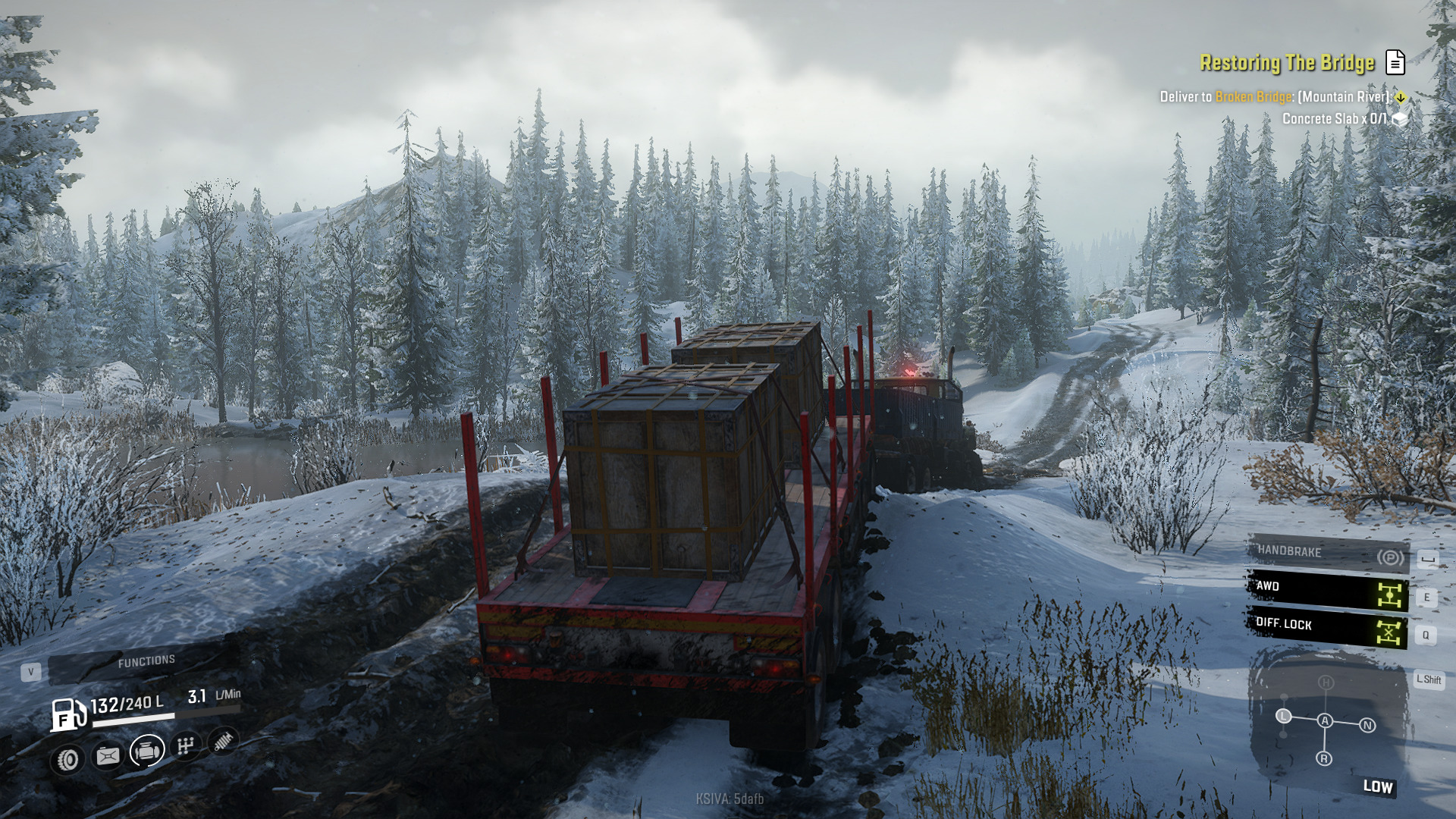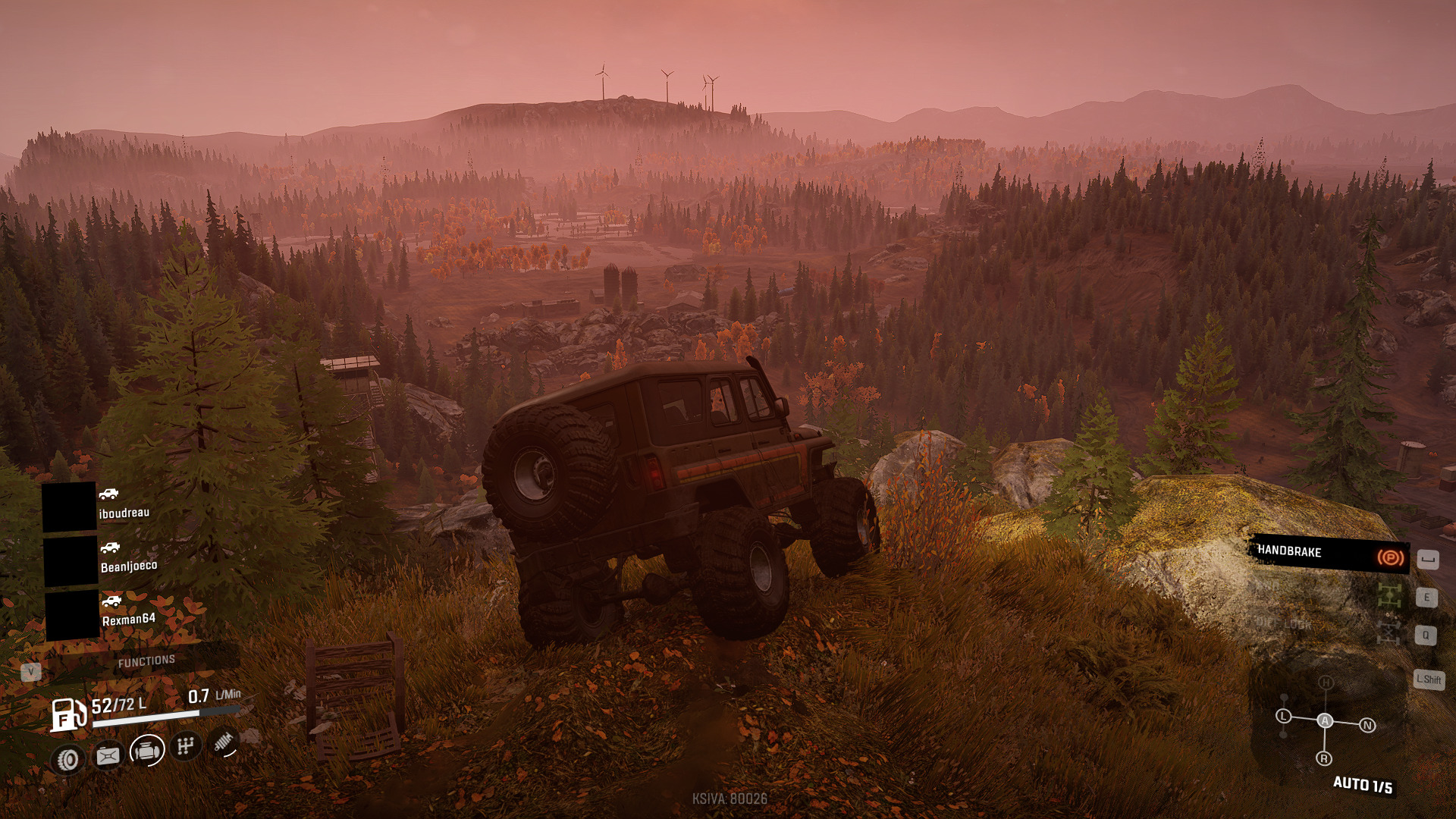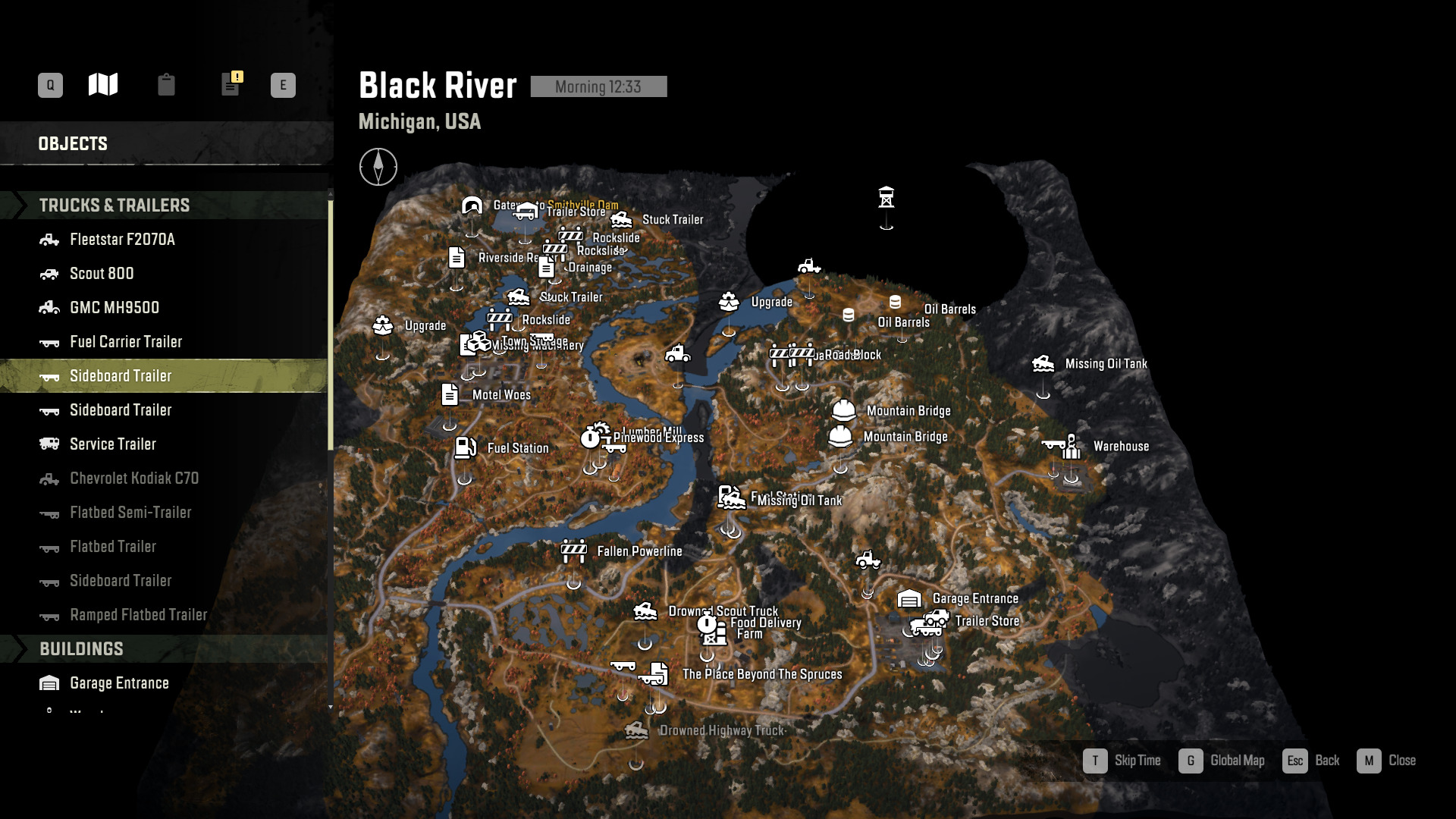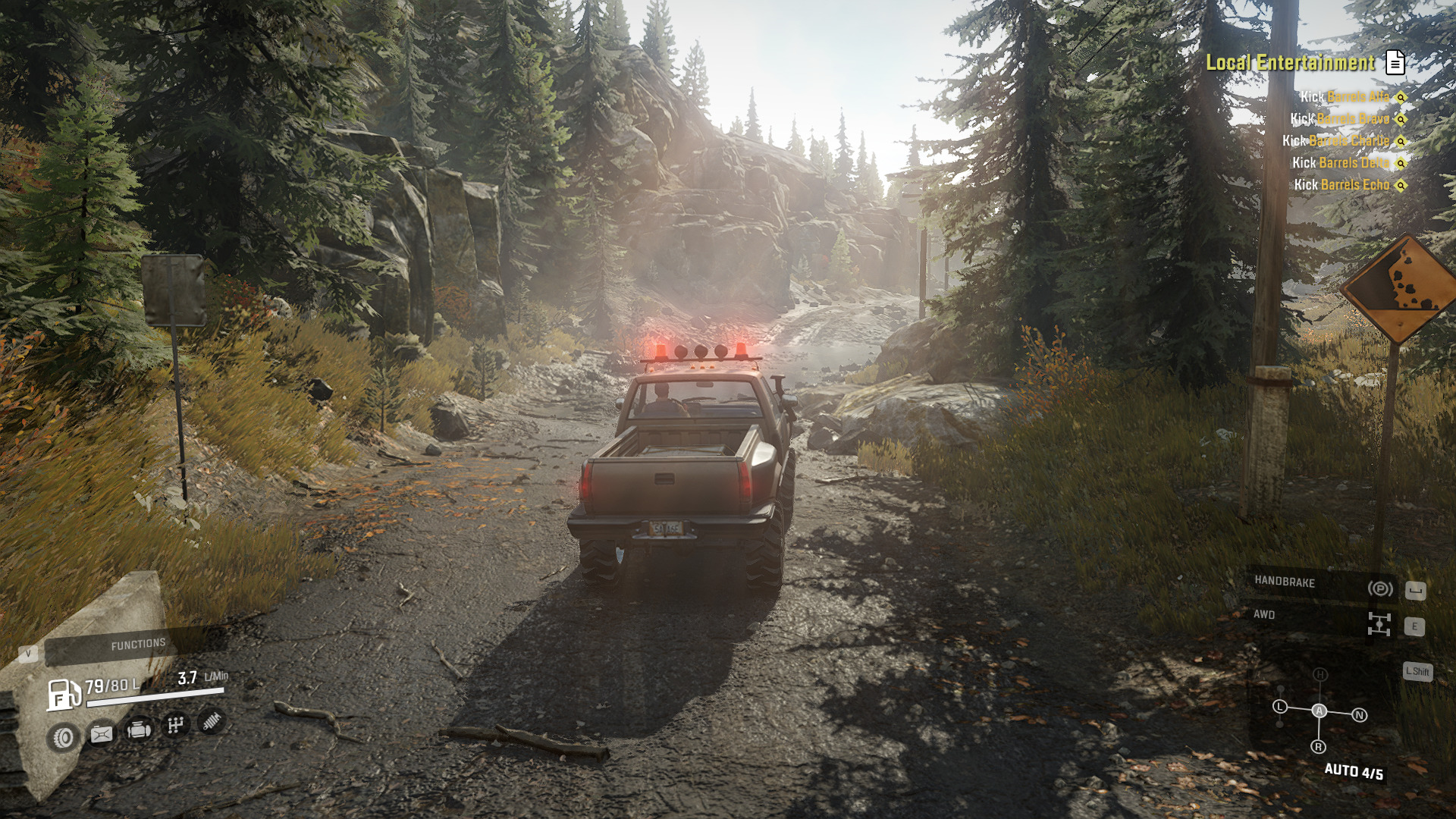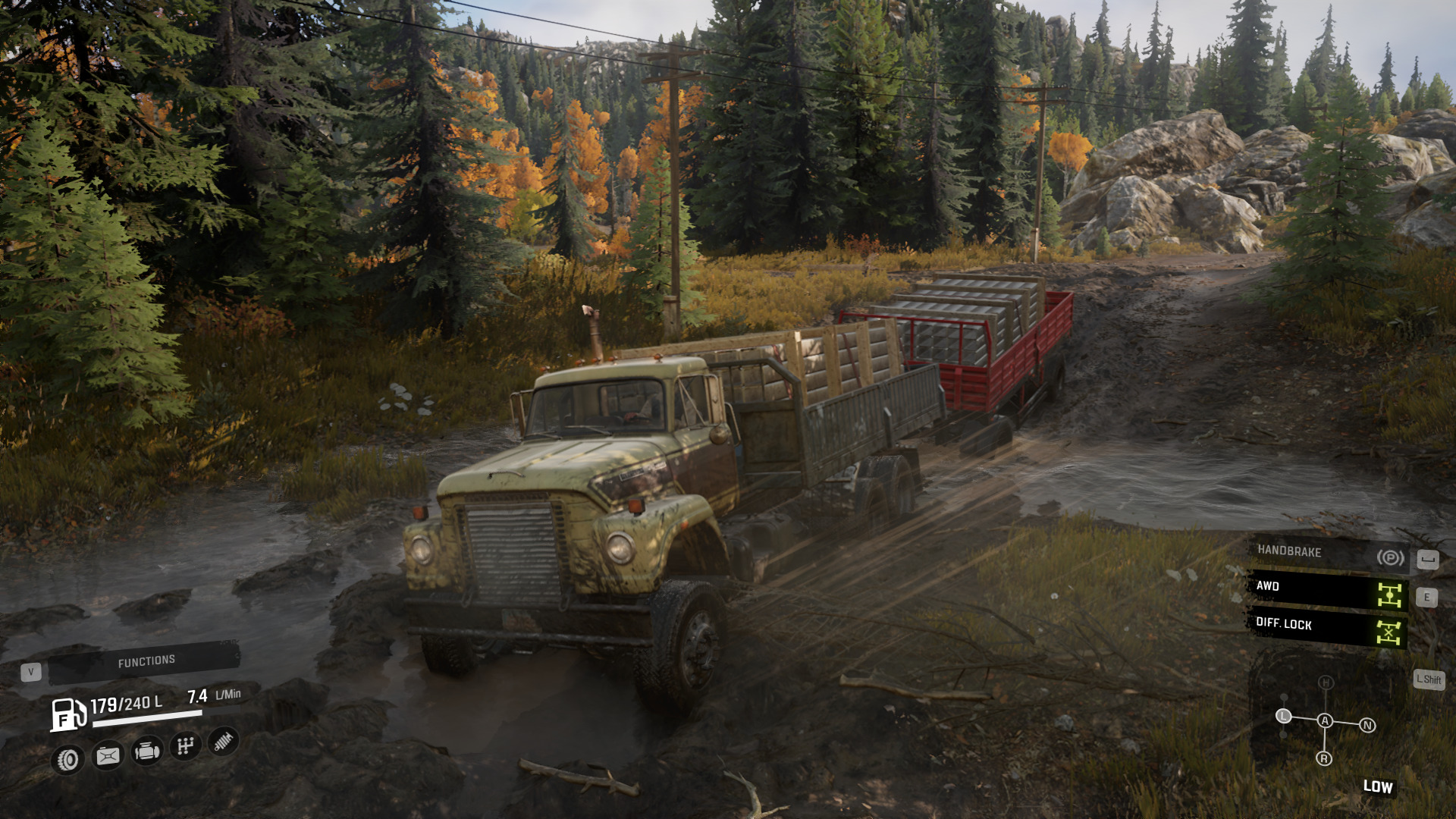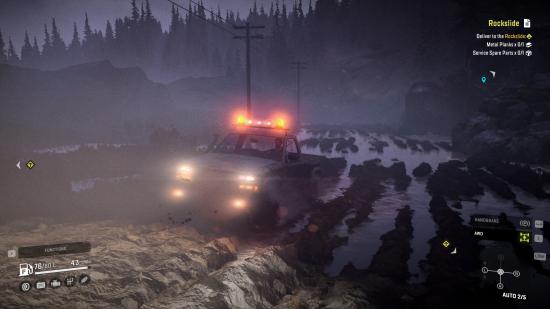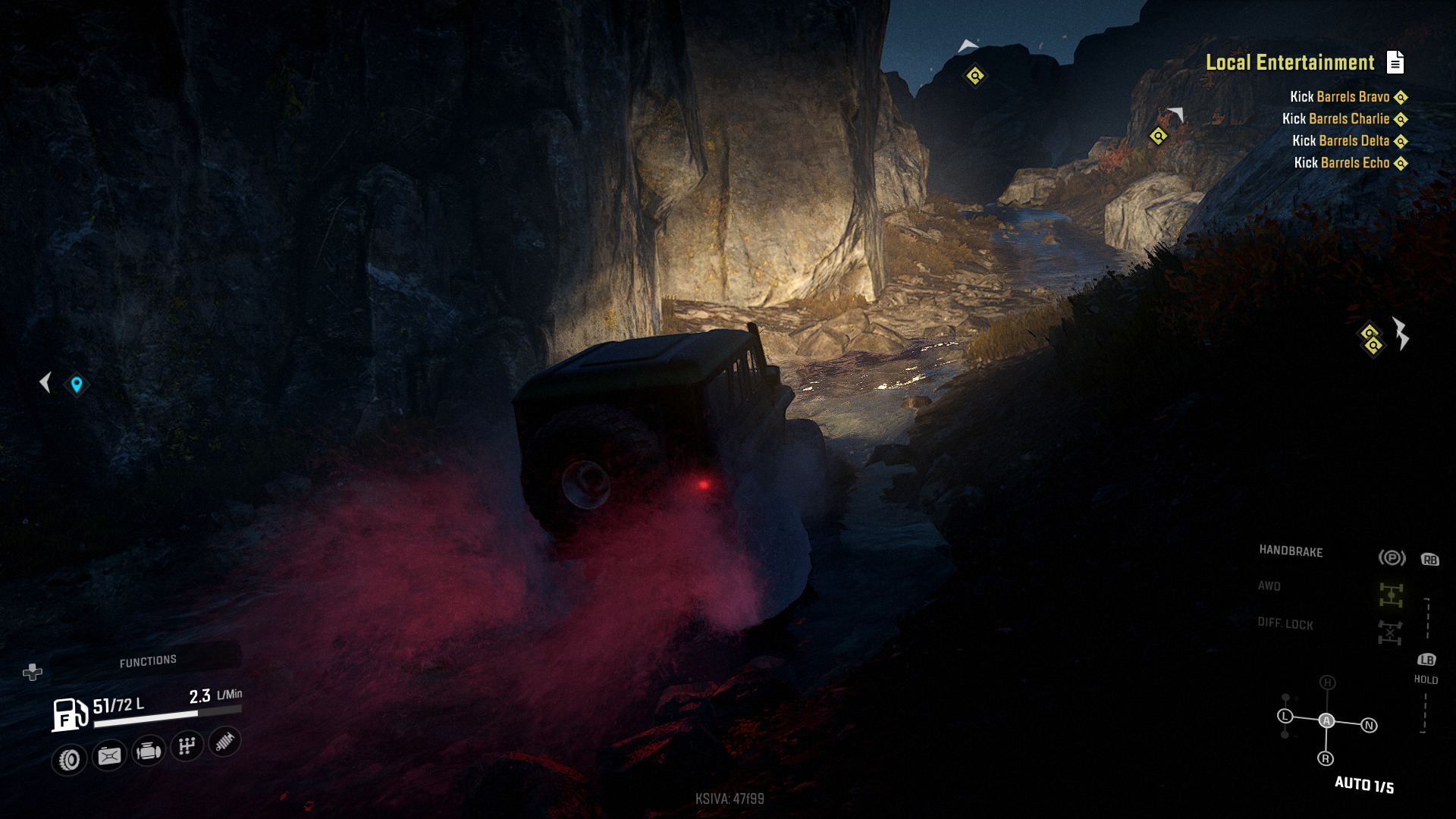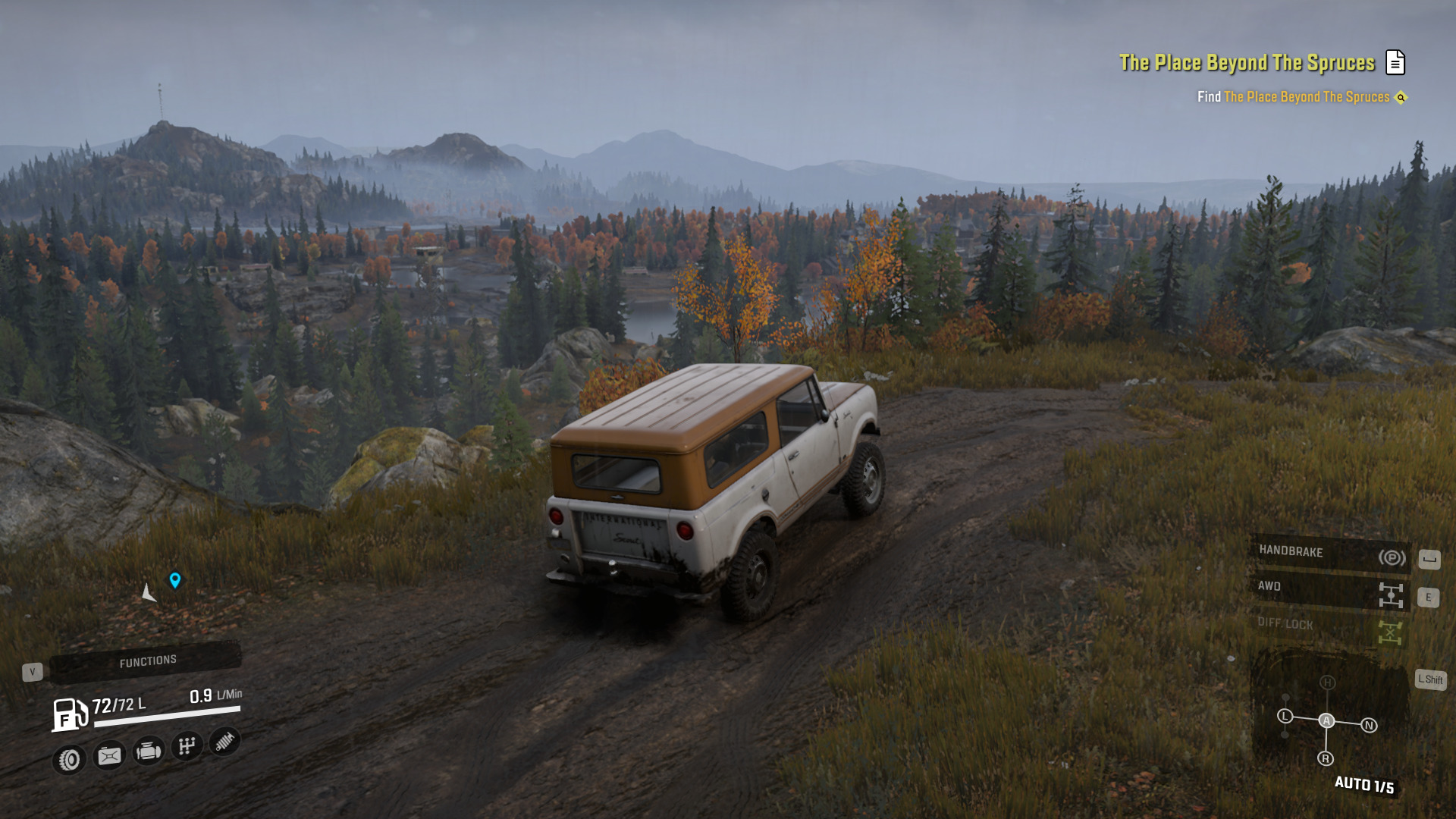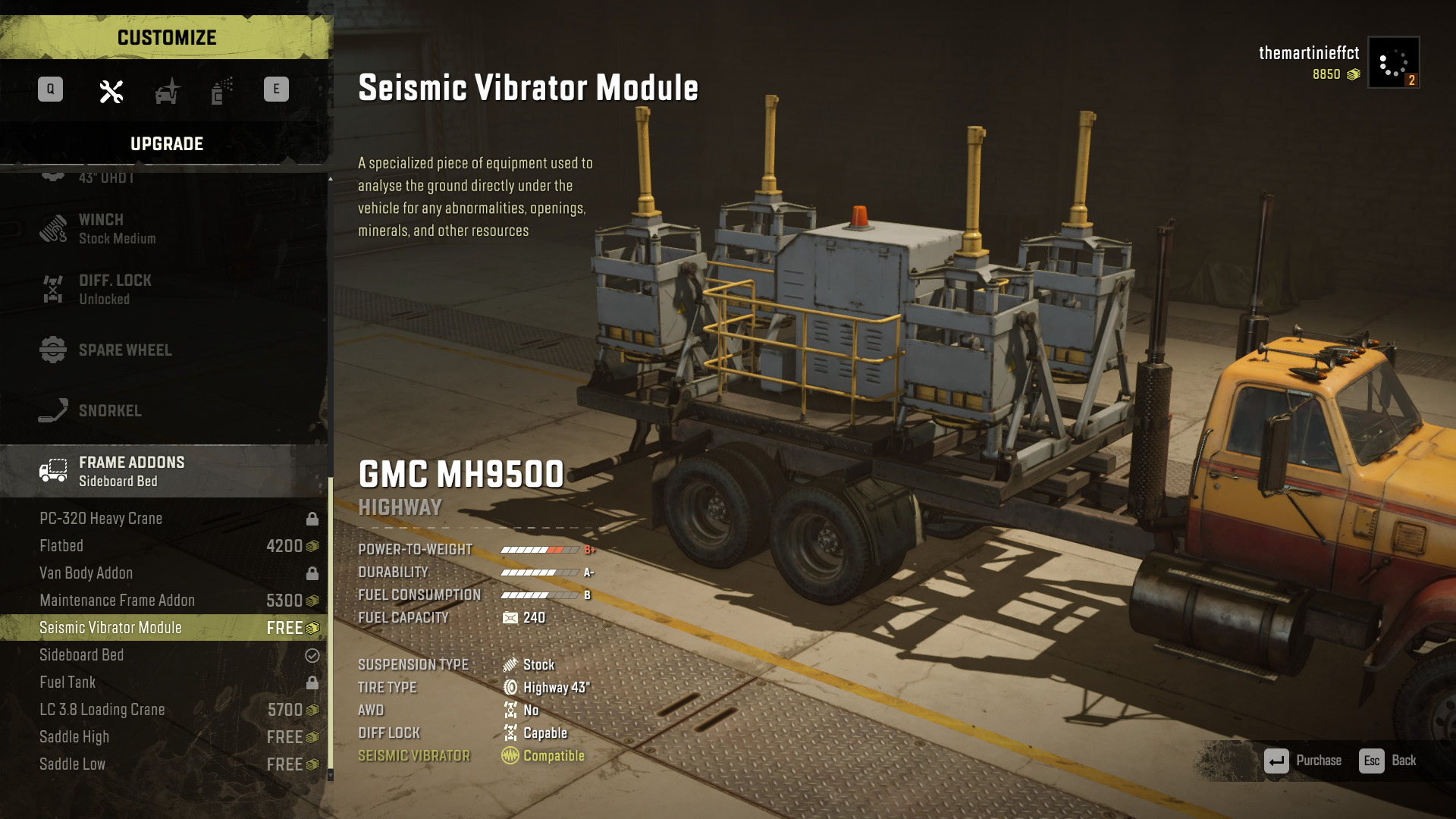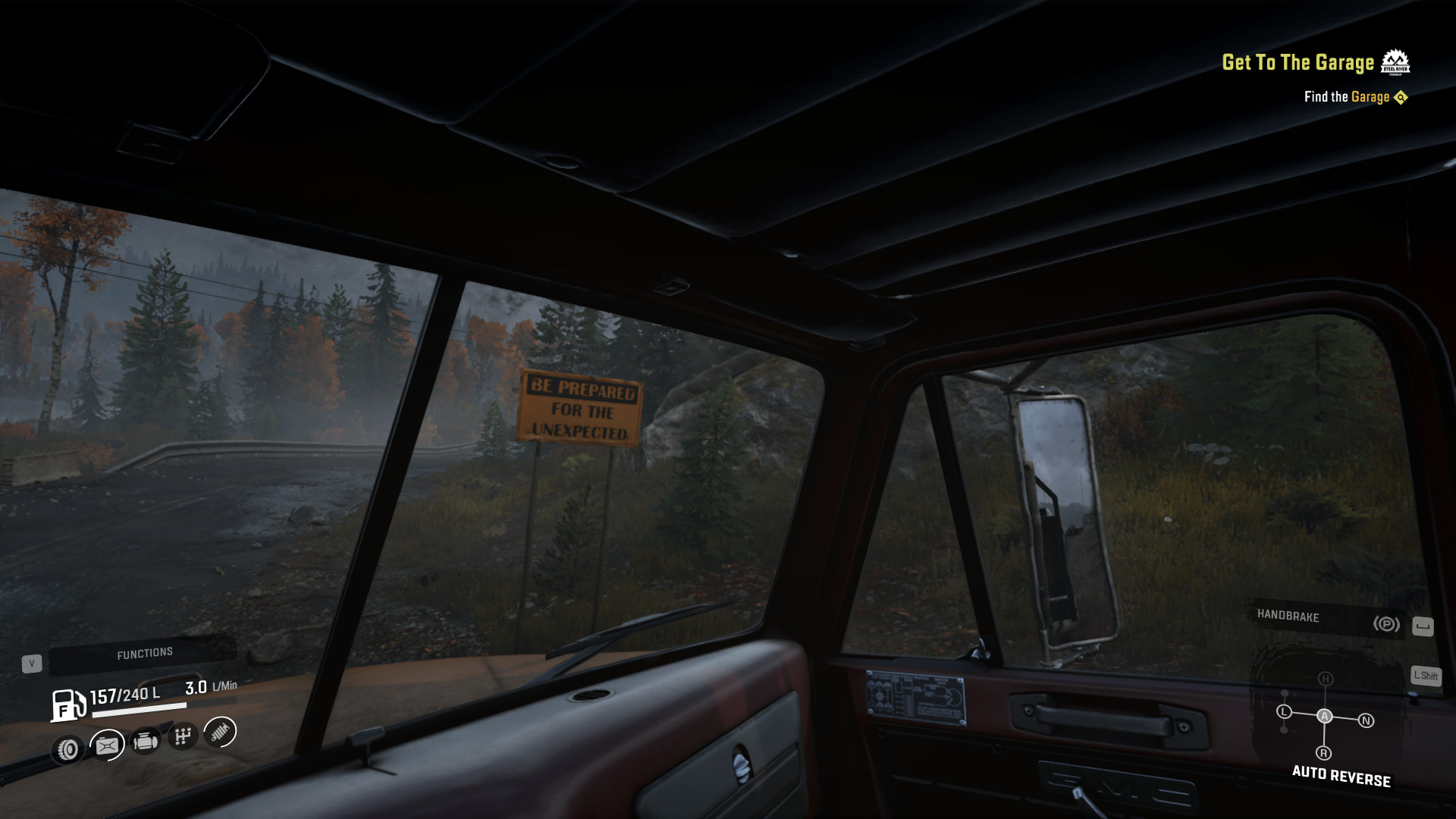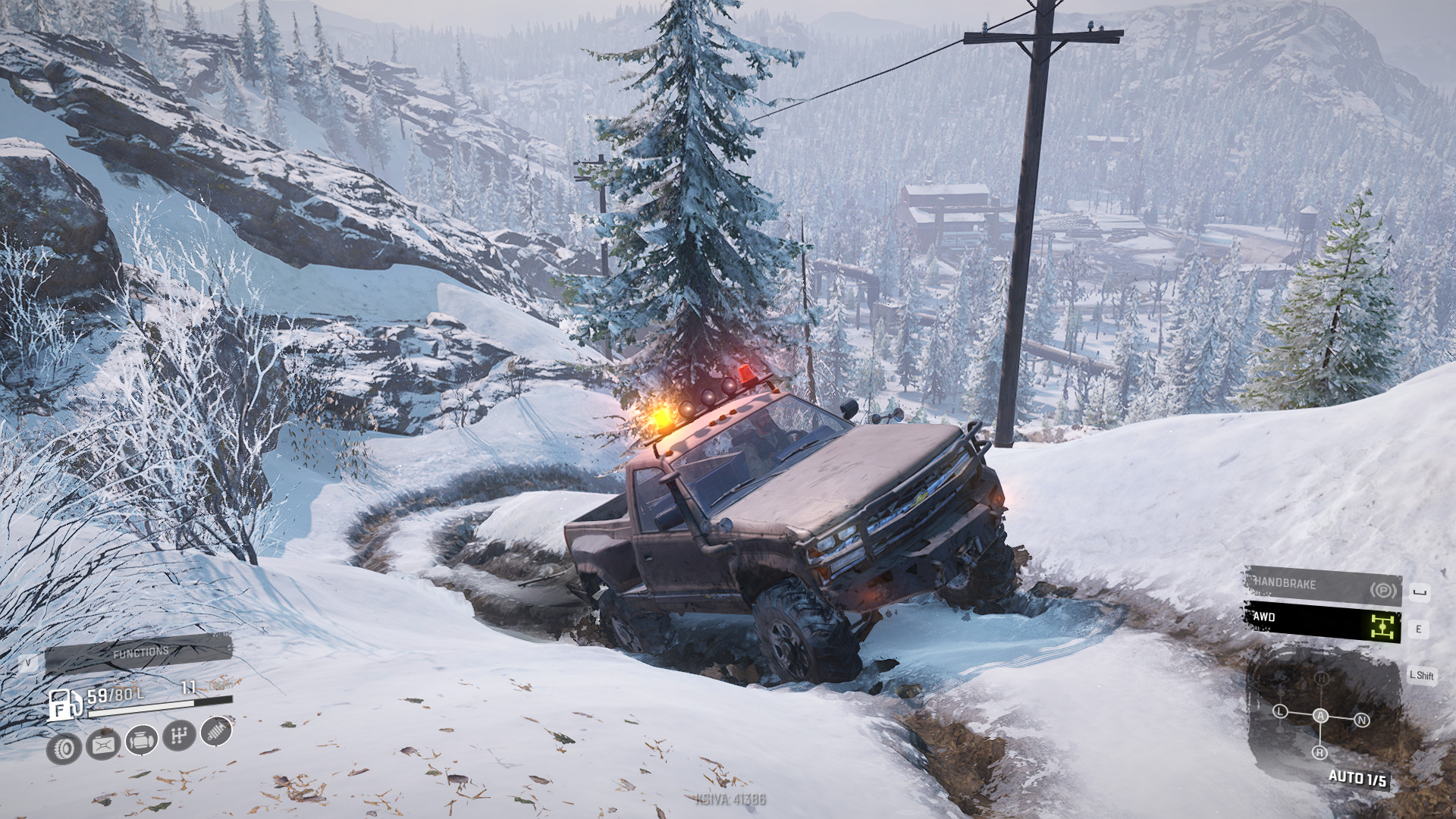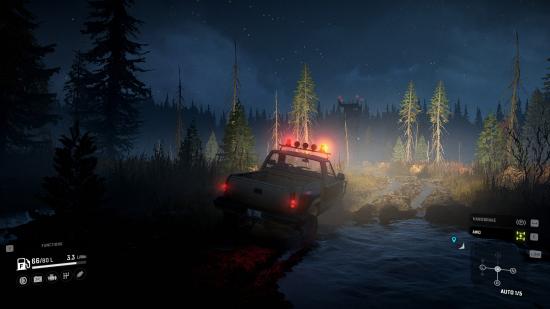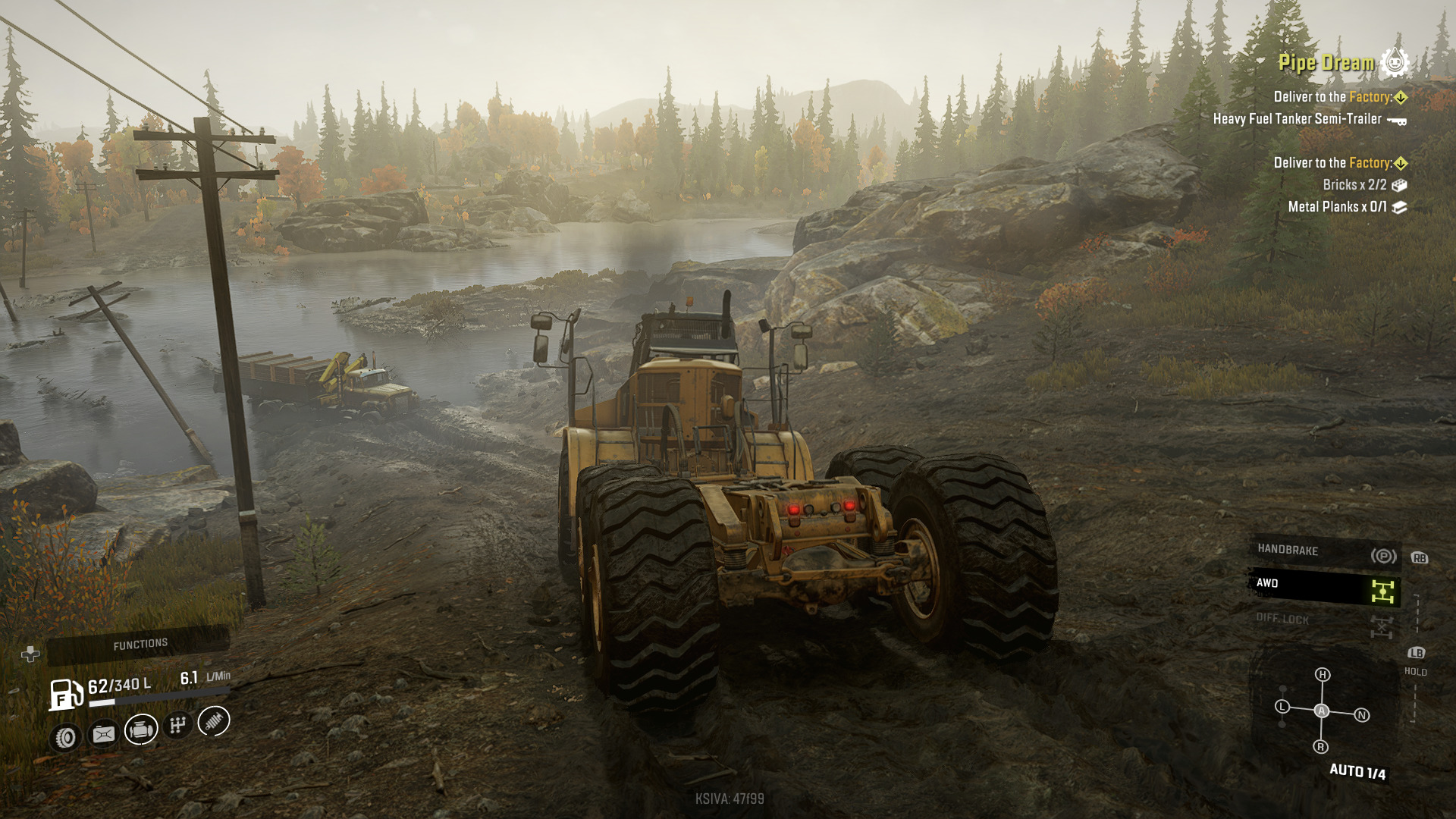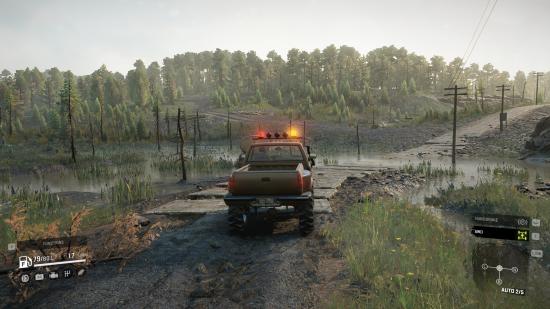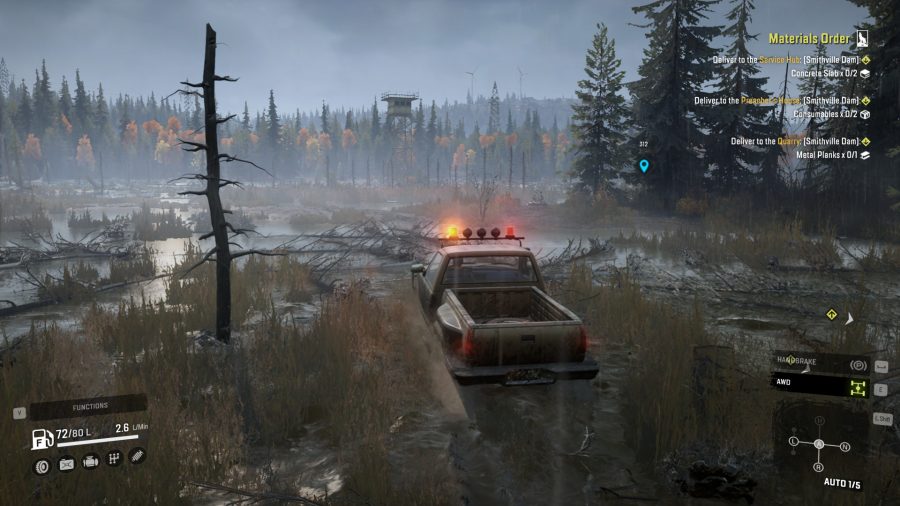Our Verdict
A beautiful-looking simulation with very specific appeal that will likely turn off as many people as it interests. If you’re in the latter group, however, this is an indispensable physics toybox.
It’s difficult to shake the feeling that, at any moment, I might disappear. Dragged from the cab of my Chevy by hitherto unseen locals, my desperate protests muffled by a dirty, calloused hand as I’m taken towards the edge of the mist-carpeted woodland beyond that abandoned-looking lumber mill, never to be heard from again.
The uneasy sense that I’m driving around in some combination of Deliverance and Twin Peaks sets in when night descends on my struggle to force ill-equipped vehicles down dirt tracks I really shouldn’t. As darkness takes hold, the trailer parks, wooden churches, and indeterminately deep swamps of the game’s opening Michigan map take on a foreboding character that’s more Alan Wake than Werner Enterprises. More fright than freight.
Better roll up that driver-side window, just to be safe. This marrow-saturating disquietude is intensified by SnowRunner’s astonishing lighting (particularly at night, where occasional street lights slice through the gloom); an unexpected but entirely welcome moody film-grain filter; and a slow-burning, reverb-drenched slide guitar soundtrack that hangs in the air like a threat. Saber Interactive wants you to get lost in its world (figuratively and literally, as it happens) and has pulled no punches in its efforts to ensure that you do.
Of course, my horror-movie experience early on is all relative – the inescapable effect of pop culture influences. Everybody knows that trailer parks, dirt roads, small towns, and dark woodland mean death is coming, right?
A helpful steer: The best racing games on PC
But it should be noted that these markers have a less profound effect on two American colleagues who’ve spent a great deal of time driving actual Chevys around similar landscapes. To them, apparently, it feels like reliving cherished memories – right down to the accurately portrayed crappy knobs on the dashboard stereo – even if they do admit that the absence of any other visible life in the game, bar the occasional dog bark or bird, is unsettling.

MudRunner (formerly Spintires: MudRunner, and SnowRunner’s 2017 forebear) was all about hauling logs around appealingly bleak Siberian landscapes in decommissioned Soviet vehicles – American Wilds DLC excepting. So it’s a bit of a surprise when you find yourself in a modest town, just beyond the local motel, within minutes of starting SnowRunner. The lights are on in the bars, restaurants, and houses. There are some pleasant-looking gardens, and some in-progress roadworks. Apart from the whole fearing for your life thing it all seems rather nice. And while nobody ever emerges from their homes to greet you – instead they just watch, waiting for the moment you turn your back so that they can scurry out and reposition all the closed-road barriers, cones, and road signs you’ve knocked over – it feels like a metropolis compared to Siberia.
This urban expansion initially feels at odds with the series’ celebration of lonesome wildernesses. But it’s indicative of Saber’s far greater ambitions for this sequel, serving as a point of contrast and factoring into a slick new progression system. Those cherished isolated expanses are still there, don’t worry, but now you’ll reach them by venturing further out from the relatively gentle topography of the earlier more ‘populated’ areas.
Like MudRunner and every Ubisoft game ever, reaching watchtowers reveals large areas of the map, but now they also sprinkle job and task markers (also like every Ubisoft game ever), along with vehicle and upgrade locations (like some Ubisoft games, err, ever), about the place. Jobs form part of larger contracts that you take on from various prospecting companies looking to gain a foothold in the area and establish drilling sites and new settlements. Completing them earns you XP to unlock new missions, vehicles and components, and money to spend on them. But they also add a sense of purpose that was often lacking in the previous games, and – perhaps more surprisingly – imbue SnowRunner with real heart, too.
You see, that nagging sensation that I’m going to get jumped is probably unfounded given how much I’ve contributed, in my own small way, to this community. Among many quietly herculean efforts, I’ve delivered the materials for the construction of several bridges – wooden, concrete, and steel – which have reconnected previously cut-off locals. I’ve supplied a number of towns and work sites with food and essential materials. I’ve battled through deep snow and treacherous mud to pull innumerable marooned vehicles from what would have been boggy graves (I’m not even sure how it’s possible to get trailers and trucks so regularly this far out into marshland, but there you go). I’ve even drained the swamps, which may or may not be a satirical swipe at the current state of US politics.
And even though I’ve never seen them, the locals seem pretty grateful, too. Their jovial, pioneering spirit is conveyed in the amusingly written job briefings and completion notes which bookend every task. I’m flooded with a sense of improving each region’s infrastructure, and the living conditions of those hardy enough to make them home.
There are three regions in the base game: Michigan, Alaska, and Taymyr. Michigan offers swampland, mountains, and dense spruce forests – Twin Peaks by night and wholesome Americana by day. Taymyr returns to Siberia and throws up expansive tracts of forested wetlands. And Alaska introduces ice and deep snow, along with some of the most arresting visuals in an already fantastic-looking game – peach-pink skies contrast with frozen ground that looks like stale chocolate cake covered in powdered sugar. It’s a delight.
The snow isn’t, as the devs have been keen to stress, just white mud, either. While you can still get stuck in it, it feels subtly different and requires a separate set of strategies and equipment to conquer. On one occasion, I set out into a map and encounter an ice-slicked road with extreme left-side camber, then watch helplessly as my chainless tyres concede victory to gravity as I slide towards the verge. As for pulling a heavy trailer through an uncompacted snowdrift without the requisite horsepower? Come back later when you’re better prepared, yeah?
Every region is split into three or four maps interconnected by tunnels. Each map is a sprawling open world in its own right – their scale exacerbated by the fact that it takes ages to battle your way through the abundant mud, snow, and fast-moving rivers – and things tend to get harder the further out you venture. Many maps have garages, which serve as fast-travel locations and allow you to customise your fleet, but some don’t – these present some of game’s most intense exploration challenges as you weigh your estimate of the unknown against your fuel needs and being sufficiently ‘not on your roof in a gulch with no recovery vehicles nearby’. On top of this, the bigger contracts require you to cross several maps, managing fuel and risk as you go.
Serious business: The best PC simulation games
The series’ most divisive aspect, the ability to get utterly stuck with little hope of rescue after hours of progress, is still present and correct – Dark Souls didn’t earn its reputation as the MudRunner of Soulslikes for nothing, y’know – but Saber has done a great deal of work to soften the landing for new players. There’s a genuinely helpful selection of tutorial missions (for which you’ll earn XP and dosh), shored up by some additional guidance when you start the main game. There’s a codex of tips and info to delve into whenever you need. And there are petrol stations located in accessible locations.
More broadly, the open-world structure is generous and well executed throughout. It quickly expands to offer a huge range of tasks of varying difficulty, and allows you to jump between regions at will if you fancy tackling another selection of jobs elsewhere. The UI is a vast improvement over MudRunner’s fiddly equivalent, too – not least when it comes to the gearbox, the options for which now fit on a single screen.
Fervent MudRunner fans may lament the absence of a hardcore mode and the fact that auto gears and loading are always available, but these tweaks are less about neutering the challenge and more about flattening the difficulty curve a little. Timed challenges still stipulate specific rules (no recovery, no truck changes etc), and upgradable gearboxes add complexity and options – the tougher tasks simply can’t be completed using auto. Loading your cargo manually, meanwhile, will bag you more XP. The combined result is a game world that more organically caters to a wider range of abilities, one gated not by impenetrable systems, but by gradually honed skill and upgraded equipment.
This setup also helps to establish a real bond with your vehicles. Whereas you just stumbled across driveable tools in MudRunner, here you customise and upgrade the vehicles you purchase or discover in the field. It’s a small but wonderful change – with 48 hours clocked in the game so far, I’m still trotting out the trusty Chevy with which you start the game. It’s beefier these days, and definitely has more lights on the roof, but it’s still the same reliable old friend that’s seen me through countless sticky situations. Watching it get bogged down in mud or snow now is like witnessing Artax give up hope in The NeverEnding Story, just more emotionally taxing.
On the topic of stressful experiences, there are still some inconveniences behind all the polish. Camera options are, for the most part, considerably improved over MudRunner’s awkward equivalent, but if you get close to anything solid it’ll flick up into the air and point straight down at your vehicle. There are some UX-flavoured bumps in the road, too – you have to activate missions before you can complete them, which grates a little when you happen across a drowned vehicle, get it all the way back, and then can’t finish the job before trekking back to the spot you found it in the first place.
Truck station: How Truck Simulator’s player-run radio show became as big as the rigs
You can also only deliver cargo from a trailer if you’re attached to it, which is annoying when you’ve ingeniously winched it where it needs to go using a vehicle that can’t otherwise connect to it. Warehouse guys: it’s right there – why are you forcing me to go and get another truck in order to make it official? Such inconsistencies are frustrating, sure, but easily mitigated once you understand the places in which the simulation is bent into goal-driven gaming. It’s far from ruinous.
SnowRunner presents an unusual proposition, then. It’s a game that, externally at least, has all the trappings of a slickly produced, triple-A mainstream game – but what lurks beneath that facade is an uncompromising, sometimes brutal simulation. Succeeding within that framework delivers an immense sense of achievement, however – just getting to the top of a tricky ascent or hauling a load down a particularly treacherous path is tantamount to besting that Souls boss you’ve spent several nights banging your head against. But it’s difficult to convey how exciting the ‘Runner games’ glacial pacing can be.
The reality is that a great deal of the players who bounced off MudRunner are unlikely to find salvation here. But some will, and for those already smitten with the core concept in spite of the series’ foibles, SnowRunner represents an astonishing realisation of Saber’s vision.
